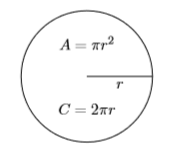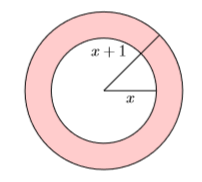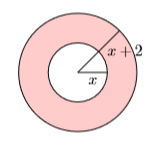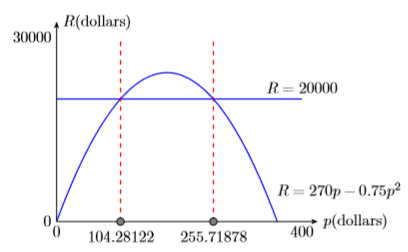5.6: Multiplicar polinomios
( \newcommand{\kernel}{\mathrm{null}\,}\)
En esta sección encontraremos los productos de expresiones y funciones polinómicas. Comenzamos con el producto de dos monomios, luego egresamos al producto de un monomio y polinomio, y completamos el estudio encontrando el producto de cualquiera de dos polinomios.
El Producto de los Monomios
Mientras todas las operaciones sean multiplicadoras, podemos usar las propiedades conmutativas y asociativas para cambiar el orden y reagruparnos.
Ejemplo5.6.1
Multiplicar:−5(7y). Simplificar:−5(7y).
Solución
Utilice las propiedades conmutativas y asociativas para cambiar el orden y reagruparse.
−5(7y)=[(−5)(7)]y Reorder. Regroup. =−35y Multiply: (−5)(7)=−35
Ejercicio5.6.1
Multiplicar:3(4x)
- Contestar
-
12x
Ejemplo5.6.2
Multiplicar:(−3x2)(4x3). Simplificar:(−3x2)(4x3).
Solución
Utilice las propiedades conmutativas y asociativas para cambiar el orden y reagruparse.
(−3x2)(4x3)=[(−3)(4)](x2x3) Reorder. Regroup. =−12x5 Multiply: (−3)(4)=12,x2x3=x5
Ejercicio5.6.2
Multiplicar:(7y5)(−2y2)
- Contestar
-
−14y7
Ejemplo5.6.3
Multiplicar:(−2a2b3)(−5a3b). Simplificar:(−2a2b3)(−5a3b).
Solución
Utilice las propiedades conmutativas y asociativas para cambiar el orden y reagruparse.
(−2a2b3)(−5a3b)=[(−2)(−5)](a2a3)(b3b) Reorder. Regroup. =10a5b4 Multiply: (−2)(−5)=10,a2a3=a5, and b3b=b4
Ejercicio5.6.3
Multiplicar:(−6st2)(3s3t4)
- Contestar
-
−18s4t6
Al multiplicar los monomios, es mucho más eficiente hacer mentalmente los cálculos requeridos. En el caso del Ejemplo5.6.1, multiplicar−5 y7 mentalmente para obtener−5(7y)=−35y En el caso del Ejemplo5.6.2,4 multiplicar−3 y obtener−12, después repetir la basex y sumar exponentes para obtener(−3x2)(4x3)=−12x5 Finalmente, en el caso del Ejemplo5.6.3, −5multiplicar−2 y obtener10, luego repetir las bases y sumar sus exponentes. (−2a2b3)(−5a3b)=10a5b4
Multiplicando un Monomio y un Polinomio
Ahora volvemos nuestra atención al producto de un monomio y un polinomio.
Ejemplo5.6.4
Multiplicar:5(3x2−4x−8)
Solución
Primero tenemos que distribuir los5 tiempos de cada término del polinomio. Entonces multiplicamos mentalmente los monomios resultantes.
5(3x2−4x−8)=5(3x2)−5(4x)−5(8)=15x2−20x−40
Ejercicio5.6.4
Multiplicar:4(−2y2+3y+5)
- Contestar
-
−8y2+12y+20
Ejemplo5.6.5
Multiplicar:2y(−3y+5)
Solución
Primero tenemos que distribuir los2y tiempos de cada término del polinomio. Entonces multiplicamos mentalmente los monomios resultantes.
2y(−3y+5)=2y(−3y)+2y(5)=−6y2+10y
Ejercicio5.6.5
Multiplicar:−3x(4−2x)
- Contestar
-
−12x+6x2
Ejemplo5.6.6
Multiplicar:−3ab(a2+2ab−b2)
Solución
Primero tenemos que distribuir los−3ab tiempos de cada término del polinomio. Entonces multiplicamos mentalmente los monomios resultantes.
−3ab(a2+2ab−b2)=−3ab(a2)+(−3ab)(2ab)−(−3ab)(b2)=−3a3b+(−6a2b2)−(−3ab3)=−3a3b−6a2b2+3ab3
Solución alternativa:
Es mucho más eficiente realizar la mayoría de los pasos del producto−3ab(a2+2ab−b2) mentalmente. Sabemos que debemos−3ab multiplicar por cada uno de los términos del polinomioa2+2ab−b2. Aquí están nuestros cálculos mentales:
- −3abvecesa2 es igual−3a3b.
- −3abveces2ab es igual−6a2b2.
- −3abveces−b2 es igual3ab3.
Pensar de esta manera nos permite anotar la respuesta sin ninguno de los pasos mostrados en nuestra primera solución. Es decir, inmediatamente escribimos:
−3ab(a2+2ab−b2)=−3a3b−6a2b2+3ab3
Ejercicio5.6.6
Multiplicar:2xy(x2−4xy2+7x)
- Contestar
-
2x3y−8x2y3+14x2y
Ejemplo5.6.7
Multiplicar:−2z2(z3+4z2−11)
Solución
Primero tenemos que distribuir los−2z2 tiempos de cada término del polinomio. Entonces multiplicamos mentalmente los monomios resultantes.
−2z2(z3+4z2−11)=−2z2(z3)+(−2z2)(4z2)−(−2z2)(11)=−2z5+(−8z4)−(−22z2)=−2z5−8z4+22z2
Solución alternativa:
Es mucho más eficiente realizar la mayoría de los pasos del producto−2z2(z3+4z2−11) mentalmente. Sabemos que debemos−2z2 multiplicar por cada uno de los términos del polinomioz3+4z2−11. Aquí están nuestros cálculos mentales:
- −2z2vecesz3 es igual−2z5.
- −2z2veces4z2 es igual−8z4.
- −2z2veces−11 es igual22z2.
Pensar de esta manera nos permite anotar la respuesta sin ninguno de los pasos mostrados en nuestra primera solución. Es decir, inmediatamente escribimos:
−2z2(z3+4z2−11)=−2z5−8z4+22z2
Ejercicio5.6.7
Multiplicar:−5y3(y2−2y+1)
- Contestar
-
−5y5+10y4−5y3
Multiplicar polinomios
Ahora que hemos aprendido a tomar el producto de dos monomios o el producto de un monomio y un polinomio, podemos aplicar lo que hemos aprendido para multiplicar dos polinomios arbitrarios.
Antes de comenzar con los ejemplos, volvamos a visitar la propiedad distributiva. Sabemos que2⋅(3+4)=2⋅3+2⋅4 Ambas partes son iguales a14. Estamos acostumbrados a tener el factor monomio a la izquierda, pero también puede aparecer a la derecha. (3+4)⋅2=3⋅2+4⋅2Nuevamente, ambos lados igualan14. Entonces, si el monomio aparece a la izquierda o a la derecha no hace diferencia; es decir,a(b+c)=ab+ac y(b+c)a=ba+ca dar el mismo resultado. En cada caso,a multiplicas por ambos términos deb+c.
Ejemplo5.6.8
Multiplicar:(2x+5)(3x+2)
Solución
Tenga en cuenta que(2x+5)(3x+2) tiene la forma(b+c)a, dondea está el binomio3x+2. Porque(b+c)a=ba+ca, vamos a3x+2 multiplicar por ambos términos2x+5 de la siguiente manera.
(2x+5)(3x+2)=2x(3x+2)+5(3x+2)
Ahora distribuimos monomios tiempos polinomios, luego combinamos términos similares.
=6x2+4x+15x+10=6x2+19x+10
Por lo tanto,(2x+5)(3x+2)=6x2+19x+10
Ejercicio5.6.8
Multiplicar:(3x+4)(5x+1)
- Contestar
-
15x2+23x+4
Ejemplo5.6.9
Multiplicar:(x+5)(x2+2x+7)
Solución
Tenga en cuenta que(x+5)(x2+2x+7) tiene la forma(b+c)a, dondea está el trinomiox2+2x+7. Porque(b+c)a=ba+ca, vamos ax2+2x+7 multiplicar por ambos términosx+5 de la siguiente manera.
(x+5)(x2+2x+7)=x(x2+2x+7)+5(x2+2x+7)
Ahora distribuimos monomios tiempos polinomios, luego combinamos términos similares.
=x3+2x2+7x+5x2+10x+35=x3+7x2+17x+35
Por lo tanto,(x+5)(x2+2x+7)=x3+7x2+17x+35
Ejercicio5.6.9
Multiplicar:(z+4)(z2+3z+9)
- Contestar
-
z3+7z2+21z+36
Acelerar un poco las cosas
Reexaminemos Ejemplo5.6.9 con la esperanza de desenterrar un patrón que permita que la multiplicación de polinomios proceda más rápidamente con menos trabajo. Observe el primer paso del Ejemplo5.6.9.
(x+5)(x2+2x+7)=x(x2+2x+7)+5(x2+2x+7)
Tenga en cuenta que el primer producto a la derecha es el resultado de tomar el producto del primer término dex+5 yx2+2x+7. De igual manera, el segundo producto a la derecha es el resultado de tomar el producto del segundo término dex+5 yx2+2x+7. A continuación, examinemos el resultado del segundo paso.
(x+5)(x2+2x+7)=x3+2x2+7x+5x2+10x+35
Los tres primeros términos de la derecha son el resultado de multiplicarx tiemposx2+2x+7.

El segundo conjunto de tres términos a la derecha son el resultado de multiplicar5 tiemposx2+2x+7.

Estas notas sugieren un atajo eficiente. Para multiplicarx+5 los tiemposx2+2x+7,
- Multiplicarx veces cada término dex2+2x+7.
- Multiplicar5 veces cada término dex2+2x+7.
- Combina términos similares.
Este proceso tendría la siguiente apariencia.
(x+5)(x2+2x+7)=x3+2x2+7x+5x2+10x+35=x3+7x2+17x+35
Ejemplo5.6.10
Utilice la técnica de atajo descrita anteriormente para simplificar:(2y−6)(3y2+4y+11)
Solución
Multiplicar2y veces cada término de3y2+4y+11, luego−6 multiplicar por cada término de3y2+4y+11. Por último, combina términos similares.
(2y−6)(3y2+4y+11)=6y3+8y2+22y−18y2−24y−66=6y3−10y2−2y−66
Ejercicio5.6.10
Multiplicar:(3x+2)(4x2−x+10)
- Contestar
-
12x3+5x2+28x+20
Ejemplo5.6.11
Utilice la técnica de atajo para simplificar(a+b)2
Solución
Para simplificar(a+b)2, primero debemos escribira+b como factor dos veces.
(a+b)2=(a+b)(a+b)
A continuación, multiplicar a veces ambos términos dea+b, multiplicar b por ambos términos dea+b, luego combinar términos similares.
=a2+ab+ba+b2=a2+2ab+b2
Tenga en cuenta queab=ba debido a que la multiplicación es conmutativa, entoncesab+ba=2ab.
Ejercicio5.6.11
Multiplicar:(3y−2)2
- Contestar
-
9y2−12y+4
Ejemplo5.6.12
Utilice la técnica de atajo para simplificar:(x2+x+1)(x2−x−1)
Solución
Esta vez el primer factor contiene tres términos,x2,x, y1, así que primerox2 multiplicamos por cada término dex2−x−1, luegox por cada término dex2−x−1, y1 por cada término dex2−x−1. Entonces combinamos términos similares.
(x2+x+1)(x2−x−1)=x4−x3−x2+x3−x2−x+x2−x−1=x4−x2−2x−1
Ejercicio5.6.12
Multiplicar:(a2−2a+3)(a2+2a−3)
- Contestar
-
a4−4a2+12a−9
Algunas aplicaciones
Recordemos que el área de un círculo de radior se encuentra usando la fórmulaA=πr2. La circunferencia (distancia alrededor) de un círculo de radior se encuentra usando la fórmulaC=2πr (ver Figura5.6.1).

Ejemplo5.6.13
En la Figura5.6.2 se representan dos círculos concéntricos (mismo centro). El círculo interior tiene radiox y el círculo exterior tiene radiox+1. Encuentra el área de la región sombreada (llamada anillo) en función dex.

Solución
Podemos encontrar el área de la región sombreada restando el área del círculo interno del área del círculo exterior.
A= Area of outer circle - Area of inner circle
Utilizamos la fórmulaA=πr2 para calcular el área de cada círculo. Debido a que el círculo exterior tiene radiox+1, tiene áreaπ(x+1)2. Debido a que el círculo interno tiene radiox, tiene áreaπx2.
=π(x+1)2−πx2
A continuación, expandiremos(x+1)2, luego combinaremos términos similares.
=π(x+1)(x+1)−πx2=π(x2+x+x+1)−πx2=π(x2+2x+1)−πx2
Por último, distribuirπ veces cada término dex2+2x+1, luego combinar términos similares.
=πx2+2πx+π−πx2=2πx+π
De ahí que el área de la región sombreada seaA=2πx+π.
Ejercicio5.6.13
A continuación se muestran dos círculos concéntricos. El círculo interior tiene radiox and the outer circle has radius x+2. Find the area of the shaded region as a function of x.

- Contestar
-
4πx+4π
Example 5.6.14
The demand for widgets is a function of the unit price, where the demand is the number of widgets the public will buy and the unit price is the amount charged for a single widget. Suppose that the demand is given by the function x=270−0.75p, where x is the demand and p is the unit price. Note how the demand decreases as the unit price goes up (makes sense). Use the graphing calculator to determine the unit price a retailer should charge for widgets so that his revenue from sales equals $20,000.
Solution
To determine the revenue (R), you multiply the number of widgets sold (x) by the unit price (p).
R=xp
However, we know that the number of units sold is the demand, given by the formula
x=270−0.75p
Substitute equation ??? into equation ??? to obtain the revenue as a function of the unit price.
R=(270−0.75p)p
Expand.
R=270p−0.75p2
We’re asked to determine the unit price that brings in a revenue of $20,000. Substitute $20,000 for R in equation ???.
20000=270p−0.75p2
Enter each side of equation ??? into the Y= menu of your calculator (see the first image in Figure 5.6.3). After some experimentation, we settled on the WINDOW parameters shown in the second image of Figure 5.6.3. After making these settings, push the GRAPH button to produce the graph shown in the third image in Figure 5.6.3.

Note that the third image in Figure 5.6.3 shows that there are two solutions, that is, two ways we can set the unit price to obtain a revenue of $20,000. To find the first solution, select 5:intersect from the CALC menu, press ENTER in response to “First curve,” press ENTER in response to “Second curve,” then move your cursor closer to the point of intersection on the left and press ENTER in response to “Guess.” The result is shown in the first image in Figure 5.6.4.
Repeat the process to find the second point of intersection. The result is shown in the second image in Figure 5.6.4.

Note
In this example, the horizontal axis is actually the p-axis. So when we set Xmin and Xmax, we’re actually setting bounds on the p-axis.
Reporting the solution on your homework:

Duplicate the image in your calculator’s viewing window on your homework page. Use a ruler to draw all lines, but freehand any curves.
- Label the horizontal and vertical axes with p and R, respectively (see Figure 5.6.5). Include the units (dollars and dollars).
- Place your WINDOW parameters at the end of each axis (see Figure 5.6.5).
- Label each graph with its equation (see Figure 5.6.5).
- Drop a dashed vertical line through each point of intersection. Shade and label the p-values of the points where the dashed vertical lines cross the p-axis. These are the solutions of the equation 20000=270p−0.75p2 (see Figure 5.6.5).
Rounding to the nearest penny, setting the unit price at either $104.28 or $255.72 will bring in a revenue of $20,000.
Exercise 5.6.14
Suppose that the demand for gadgets is given by the function x=320−1.5p, where x is the demand and p is the unit price. Use the graphing calculator to determine the unit price a retailer should charge for gadgets so that her revenue from sales equals $12,000.
- Answer
-
$48.55 or $164.79


